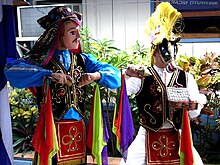The music of Latin America refers to music originating from Latin America, namely the Romance-speaking regions of the Americas south of the United States. Latin American music also incorporate the Indigenous peoples of the Americas. Due to its highly syncretic nature, Latin American music encompasses a wide variety of styles, including influential genres such as cumbia, bachata, bossa nova, merengue, rumba, salsa, samba, son, and tango. During the 20th century, many styles were influenced by the music of the United States giving rise to genres such as Latin pop, rock, jazz, hip hop, and reggaeton.
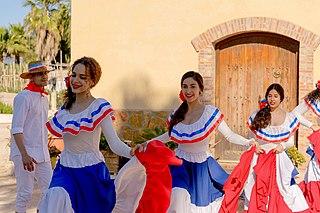
The music of the Dominican Republic is primarily influenced by Western European music, with Sub-Saharan African and native Taino influences. The Dominican Republic is mainly known for its merengue and bachata music, both of which are the most famous styles of music in the Dominican Republic, and have been exported and popularized around the world.
The music of the Lesser Antilles encompasses the music of this chain of small islands making up the eastern and southern portion of the West Indies. Lesser Antillean music is part of the broader category of Caribbean music; much of the folk and popular music is also a part of the Afro-American musical complex, being a mixture of African, European and indigenous American elements. The Lesser Antilles' musical cultures are largely based on the music of African slaves brought by European traders and colonizers. The African musical elements are a hybrid of instruments and styles from numerous West African tribes, while the European slaveholders added their own musics into the mix, as did immigrants from India. In many ways, the Lesser Antilles can be musically divided based on which nation colonized them.
The Music of Nicaragua contains a mixture of European, Indigenous, and African influences. Occasionally, it also rarely features Asian and Arab musical influences as well as from other countries of Hispanic and Latino origin. Musical instruments include the marimba and others that are common across Central America. Pop music includes performers from all around the world including Nicaraguans, Cubans, Brazilians, Mexicans, Panamanians, as well as those from Europe and the United States.

Limón is one of seven provinces in Costa Rica. The province covers an area of 9,189 km2, and has a population of 386,862.

Candombe is a style of music and dance that originated in Uruguay among the descendants of liberated African slaves. In 2009, the United Nations Educational, Scientific and Cultural Organization (UNESCO) inscribed candombe in its Representative List of the Intangible Cultural Heritage of Humanity.

Nicaraguans are people inhabiting in, originating or having significant heritage from Nicaragua. Most Nicaraguans live in Nicaragua, although there is also a significant Nicaraguan diaspora, particularly in Costa Rica and the United States with smaller communities in other countries around the world. There are also people living in Nicaragua who are not Nicaraguans because they were not born or raised in Nicaragua nor have they gained citizenship.

Marinera is a partner dance that originated along the coastal regions of Peru, using handkerchiefs as props. The dance is a mix of Spanish contradanza and Andean zamacueca, and is a stylized reenactment of a courtship, showing a blend of the different cultures of Peru. The dance has gained recognition throughout South America and is known as the most prominent traditional dance of Peru. The city of Trujillo has been recognized as the national birthplace of the marinera since 1986. The Marinera Festival, a cultural event dedicated to marinera held in Trujillo, has held annual competitions of the dance since 1960. In 2012, the Congress of Peru observed nationally October 7 as a commemorative day for the marinera.

Diriamba is a city and a municipality in the Carazo department of Nicaragua, with a population of 64,757. It is located 41 km south of Managua, the capital of Nicaragua.
Latin American culture is the formal or informal expression of the people of Latin America and includes both high culture and popular culture, as well as religion and other customary practices. These are generally of Western origin, but have various degrees of Native American, African and Asian influence.
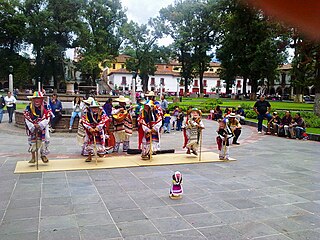
The Danza de los viejitos is a traditional folk dance in Michoacán, Mexico.
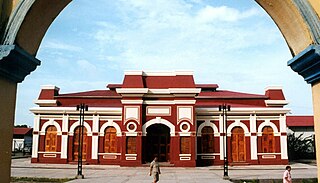
The history of rail transport in Nicaragua began in 1860s, with the first plans for a railway in Nicaragua. The first line was opened in 1882. In the past, there were 1,067 mm gauge railways on the Pacific coast, connecting major cities. A private 1,435 mm gauge line operated on the Atlantic coast.

El Güegüense is a satirical drama and was the first literary work of post-Colombian Nicaragua. It is regarded as one of Latin America's most distinctive colonial-era expressions and as Nicaragua's signature folkloric masterpiece combining music, dance and theater. There was also a monument built in the center of a rotonda (roundabout) in Managua, in its honor. El Güegüense is performed during the feast of San Sebastián in Diriamba from 17 to 27 January.
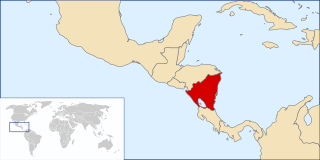
The following is an alphabetical list of topics related to Nicaragua.
Palo de Mayo is a type of Afro-Caribbean dance with sensual movements that forms part of the culture of several communities in the RAAS region in Nicaragua, as well as Belize, the Bay Islands of Honduras and Bocas del Toro in Panama. It is also the name given to the month-long May Day festival celebrated on the Caribbean coast. Both the festival and dance are an Afro-Nicaraguan tradition which originated in Bluefields, Nicaragua in the 17th century.
Nicaraguan literature can be traced to pre-Columbian times with the myths and oral literature that formed the cosmogonic view of the world that indigenous people had. They told him that of these stories are still known in Nicaragua. Like many Latin American countries, the Spanish conquerors have had the most effect on both the culture and the literature. The literature of Nicaragua has had many important literary figures in the Spanish language with internationally prominent writers such as Rubén Darío, who is regarded as the most important literary figure in Nicaragua. He is referred to as the "Father of Modernism" for leading the modernismo literary movement at the end of the 19th century. Other important literary figures include Salomón de la Selva, Carlos Martínez Rivas, Pablo Antonio Cuadra, Alberto Cuadra Mejia, Manolo Cuadra Vega, Pablo Alberto Cuadra Arguello, Ernesto Cardenal, Sergio Ramírez Mercado, Gioconda Belli, José Coronel Urtecho, Alfonso Cortés, Julio Valle Castillo, and Claribel Alegría, among others.
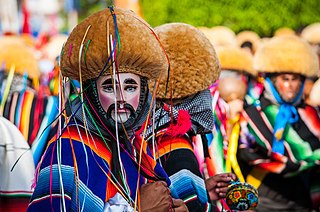
The Parachico or Parachicos are traditional dancers from Chiapa de Corzo, Chiapas, Mexico, who dance on the streets of the town during the Grand Fiesta festivities, which take place from January 15 to 23 every year. The festival honors the local patron saints the Black Christ of Esquipulas, Saint Anthony Abbot, and Saint Sebastian. It is claimed locally that, like many of the Catholic festivals in Latin America, it has its roots in the much older indigenous culture. So it has developed into a hybrid of old indigenous culture and newer Catholic and Spanish cultures. The church where the festival concludes is home to an old tree which, according to residents, predates the church. This tree is said to represent the "tree of life", which would suggest that this site was used for ceremonies before the arrival of Catholicism.

Mexican mask-folk art refers to the making and use of masks for various traditional dances and ceremony in Mexico. Evidence of mask making in the region extends for thousands of years and was a well-established part of ritual life in the pre-Hispanic territories that are now Mexico well before the Spanish conquest of the Aztec Empire occurred. In the early colonial period, evangelists took advantage of native customs of dance and mask to teach the Catholic faith although later, colonial authorities tried to ban both unsuccessfully. After the Mexican Independence, mask and dance traditions showed a syncretism and mask traditions have continued to evolve into new forms, depicting Mexico's history and newer forms of popular culture such as lucha libre. Most traditional masks are made of wood, with others made from leather, wax, cardboard, papier-mâché and other materials. Common depictions in masks include Europeans, Afro-Mexicans, old men and women, animals, as well as the fantastic or the supernatural, especially demons or the devil.

Folk dance of Mexico, commonly known as baile folklorico or Mexican ballet folk dance, is a term used to collectively describe traditional Mexican folk dances. Ballet folklórico is not just one type of dance, it encompasses each region's traditional dance that has been influenced by their local folklore and has been entwined with ballet characteristics to be made into a theatrical production. Each dance represents a different region in Mexico illustrated through their different zapateado, footwork, having differing stomps or heel toe points, and choreography that imitates animals from their region such as horses, iguanas, and vultures.
